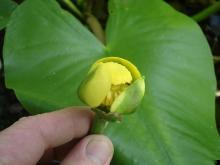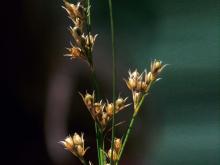Wildflowers, Grasses and Other Nonwoody Plants
Media

Species Types
Scientific Name
Dioscorea oppositifolia (sometimes called D. batatas)
Description
Similar to kudzu, Chinese yam is an aggressive vine that overtakes nearly everything within reach that stands still long enough! Learn more about this invasive plant — and please don’t plant it!
Media

Species Types
Scientific Name
Nuphar advena (formerly N. lutea)
Description
Spatterdock is a native aquatic plant with deep yellow, saucer-or globe-shaped flowers to 3 inches across. It grows in ponds, lakes, and slow-moving to stagnant portions of streams, rivers, and spring branches.
Media

Species Types
Scientific Name
Najas spp.
Description
Naiads are slender, narrow-leaved plants that grow completely under water and are rooted to the bottom. They never have broad, floating leaves or conspicuous flowers or seed heads.
Media

Species Types
Scientific Name
Fallopia japonica
Description
One of the worst invasive species in the world, Japanese knotweed can thrive in many places and can even damage foundations of buildings — not to mention the harm it causes in natural habitats. Learn to recognize it so you can prevent its spread.
Media

Species Types
Scientific Name
Ambrosia trifida
Description
Large stands of wind-pollinated giant ragweed commonly form in disturbed areas, causing late-summer misery in the form of hay fever for many Missourians.
Media

Species Types
Scientific Name
All true grasses (species in the grass family)
Description
Missouri has 276 species in the grass family, including well-known crop plants and our native prairie grasses. Distinguishing between the species can be difficult, but it’s easy to learn some basics about the group.
Media

Species Types
Scientific Name
Phalaris arundinacea
Description
Reed canary grass is native to Europe, Asia, and North America, and it varies quite a bit. Our native Missouri version, for instance, is quite different from the Eurasian type that has been widely introduced — and which has proven to be highly invasive.
Media

Species Types
Scientific Name
Juncus spp. and Luzula spp.
Description
Missouri has 24 species in the rush family. Distinguishing between these grasslike plants can be tricky, but it’s easy to learn some basics about the group.
Media

Species Types
Scientific Name
Carex, Schoenoplectus, Scirpus, and other genera
Description
Missouri has more than 200 species in the sedge family. Distinguishing between these grasslike plants can be difficult, but it’s easy to learn some basics about the group.
Media

Species Types
Scientific Name
Xanthium strumarium
Description
Common cocklebur occurs statewide in open, disturbed, lowland habitats. It is a common weed in crop fields. It has wide, rough, coarsely toothed leaves; stout, often purple-speckled stems; and characteristic burs with hooked spines.
See Also
About Wildflowers, Grasses and Other Nonwoody Plants in Missouri
A very simple way of thinking about the green world is to divide the vascular plants into two groups: woody and nonwoody (or herbaceous). But this is an artificial division; many plant families include some species that are woody and some that are not. The diversity of nonwoody vascular plants is staggering! Think of all the ferns, grasses, sedges, lilies, peas, sunflowers, nightshades, milkweeds, mustards, mints, and mallows — weeds and wildflowers — and many more!





















